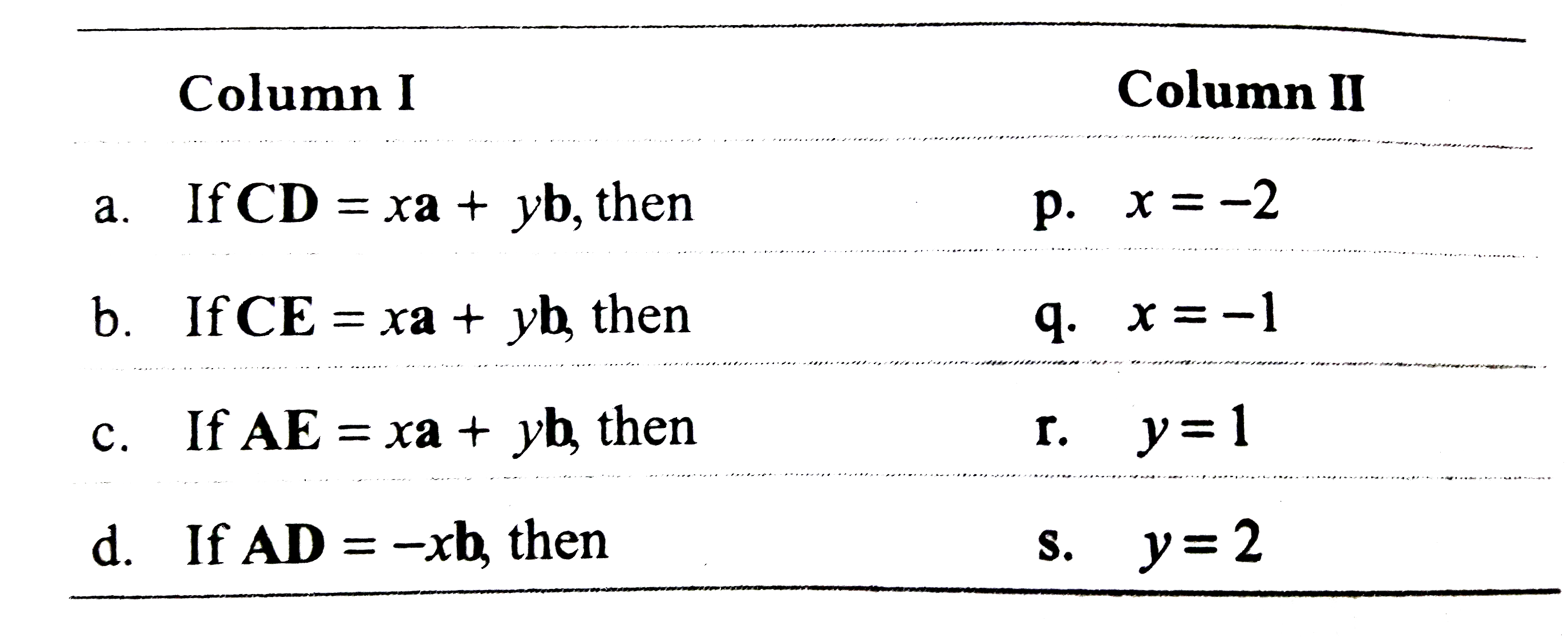→aand→b form the consecutive sides of a regular hexagon ABCDEF.

Text Solution
The correct Answer is:a→q,r;b→p,r;c→q,s;d→p

−−→AB=→a,−−→BC=→b ltvrgt ∴−−→AC=−−→AB+−−→BC=→a+→a (i)
−−→AD=2−−→BC=2→b (ii)
(because AD is parallel to BC and twice its length).
−−→CD=−−→AD−−−→AC=2→b−(→a+→b)
=→b−→a
−−→FA=−−−→CD=→a−→b (iii)
−−→DE=−−−→AB=−→a (iv)
−−→EF=−−−→BC=−→b (v)
−−→AE=−−→AD+−−→DE=2→b−→a (vi)
−−→CE=−−→CD+−−→DE=→b−→a−→a=→b−2→a (vii)
|
Topper's Solved these Questions
- INTRODUCTION TO VECTORS BOOK - CENGAGECHAPTER - INTRODUCTION TO VECTORS EXERCISE - Exercise (Numerical)
6 Videos
- INTRODUCTION TO VECTORS BOOK - CENGAGECHAPTER - INTRODUCTION TO VECTORS EXERCISE - JEE Previous Year
20 Videos
- INTRODUCTION TO VECTORS BOOK - CENGAGECHAPTER - INTRODUCTION TO VECTORS EXERCISE - LINKED COMPREHENSION TYPE
2 Videos
- INTEGRALSBOOK - CENGAGECHAPTER - INTEGRALSEXERCISE - Solved Examples And Exercises
222 Videos
- INVERSE TRIGONOMETRIC FUNCTIONSBOOK - CENGAGECHAPTER - INVERSE TRIGONOMETRIC FUNCTIONSEXERCISE - All Questions
529 Videos
Similar Questions
Knowledge Check
In a regular hexagon , →AE =
A→AC+→AF+→ABB→AC+→AF−→ABC→AC+→AB−→AFD−→AC+→AB−VECAFIf ¯aand¯b represent the sides ¯¯¯¯¯¯ABand¯¯¯¯¯¯BC of a regular hexagon ABCDEF, then ¯¯¯¯¯¯FA=
Ab−aBa−bCa+bDnone of theseArea of a regular hexagon with side ‘a’ is
A3√34a2 sq. unitB122√3a2 sq. unitC92√3a2 sq. unitD6√2a2 sq. unit
In a regular hexagon ABCDEF, −−→AE
View SolutionIn a regular hexagon ABCDEF, −−→AE
View SolutionThe coordinates of two consecutive vertices A and B of a regular hexagon ABCDEF are (1,0) and (2,0) respectively. The equation of the diagonal CE is:
View SolutionThe coordinates of two consecutive vertices A and B of a regular hexagon ABCDEF are (1,0) and (2,0) respectively. The equation of the diagonal CE is:
View SolutionIf →a, →b are the vectors forming consecutive sides of a regular of a regular hexagon ABCDEF, then the vector representing side CD is
View Solution

